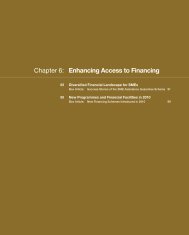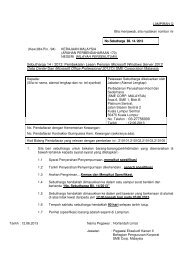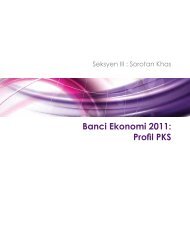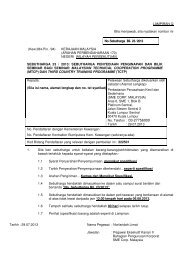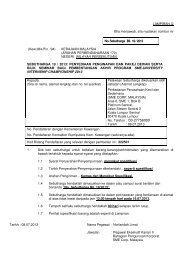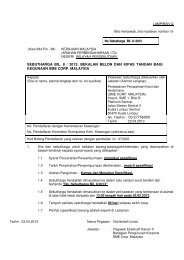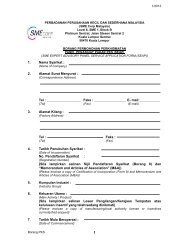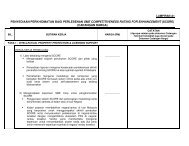- Page 1 and 2:
FinancialGuide for SMEs
- Page 3 and 4:
Financial Guide for SMEsAbout the G
- Page 5 and 6:
Financial Guide for SMEsChapter6 :
- Page 7 and 8:
Financial Guide for SMEsIntroductio
- Page 9 and 10:
Financial Guide for SMEsCreditorsCu
- Page 11 and 12:
Section I : Business Finance Basics
- Page 13 and 14:
Financial Guide for SMEsUnderstandi
- Page 15 and 16:
Financial Guide for SMEsCase Study
- Page 17 and 18:
Financial Guide for SMEsTowards the
- Page 19 and 20:
Financial Guide for SMEsBalance She
- Page 21 and 22:
Financial Guide for SMEsStatement o
- Page 23 and 24:
Financial Guide for SMEsHere is an
- Page 25 and 26:
Financial Guide for SMEsAssessing t
- Page 27 and 28:
Financial Guide for SMEsSolvency Ra
- Page 29 and 30:
Financial Guide for SMEsManagement
- Page 31 and 32:
Financial Guide for SMEs29Chapter 2
- Page 33 and 34: BudgetingBudgeting is the tool that
- Page 35 and 36: Financial Guide for SMEsAn annual b
- Page 37 and 38: Financial Guide for SMEsWe can see
- Page 39 and 40: Financial Guide for SMEsSection II
- Page 41 and 42: Financial Guide for SMEsMaintaining
- Page 43 and 44: Financial Guide for SMEsMark-upMark
- Page 45 and 46: Financial Guide for SMEsDiscounting
- Page 47 and 48: Financial Guide for SMEsExpense Man
- Page 49 and 50: Financial Guide for SMEsImproving C
- Page 51 and 52: Financial Guide for SMEsManaging In
- Page 53 and 54: Financial Guide for SMEsChecklist f
- Page 55 and 56: Financial Guide for SMEsUsing Numbe
- Page 57 and 58: Financial Guide for SMEsChecklist f
- Page 59 and 60: Financial Guide for SMEsTIPS FOR IM
- Page 61 and 62: Financial Guide for SMEsChecklist f
- Page 63 and 64: Financial Guide for SMEsChecklist f
- Page 65 and 66: Financial Guide for SMEsTIPS FOR IM
- Page 67 and 68: Financial Guide for SMEsCash Conver
- Page 69 and 70: Financial Guide for SMEsManaging Ca
- Page 71 and 72: Financial Guide for SMEsIn month 1,
- Page 73 and 74: Financial Guide for SMEsCash Flow F
- Page 75 and 76: Financial Guide for SMEsFinancial G
- Page 77 and 78: Financial Guide for SMEsStep 3: Oth
- Page 79 and 80: Financial Guide for SMEsAdam will h
- Page 81 and 82: Section III : Financing Your Busine
- Page 83: Financial Guide for SMEsDebt, Equit
- Page 87 and 88: Financial Guide for SMEsTypes of Se
- Page 89 and 90: Repayment of Debt Finance/ Investme
- Page 91 and 92: Financial Guide for SMEsAdvantagesD
- Page 93 and 94: Financial Guide for SMEsDeciding Be
- Page 95 and 96: Financial Guide for SMEsUnderstandi
- Page 97 and 98: Financial Guide for SMEsProducts fo
- Page 99 and 100: Financial Guide for SMEsPurpose Pro
- Page 101 and 102: Financial Guide for SMEsPurpose Pro
- Page 103 and 104: Financial Guide for SMEsPurpose Pro
- Page 105 and 106: Financial Guide for SMEsTransaction
- Page 107 and 108: Financial Guide for SMEs• Do you
- Page 109 and 110: Financial Guide for SMEs107chapter
- Page 111 and 112: Financial Guide for SMEsTrade Finan
- Page 113 and 114: Financial Guide for SMEsThe option
- Page 115 and 116: Financial Guide for SMEsInternation
- Page 117 and 118: Financial Guide for SMEsProduct Usa
- Page 119 and 120: Financial Guide for SMEsFinancial G
- Page 121 and 122: Section IV : Managing LendersBanker
- Page 123 and 124: Financial Guide for SMEsApplying Fo
- Page 125 and 126: Financial Guide for SMEsSME FINANCI
- Page 127 and 128: Financial Guide for SMEs2.3.4.5.Sec
- Page 129 and 130: Financial Guide for SMEs3.4.Section
- Page 131 and 132: Financial Guide for SMEsType of Doc
- Page 133 and 134: Financial Guide for SMEs3.4.5.6.7.8
- Page 135 and 136:
Financial Guide for SMEsLoan Applic
- Page 137 and 138:
Financial Guide for SMEsExample of
- Page 139 and 140:
Financial Guide for SMEssheet will
- Page 141 and 142:
Financial Guide for SMEsTo gain an
- Page 143 and 144:
Financial Guide for SMEs141chapter
- Page 145 and 146:
Financial Guide for SMEsRefinancing
- Page 147 and 148:
Financial Guide for SMEsBenefits of
- Page 149 and 150:
Financial Guide for SMEsChange in v
- Page 151 and 152:
Financial Guide for SMEsBanking Rev
- Page 153 and 154:
Financial Guide for SMEsYou should
- Page 155 and 156:
Financial Guide for SMEsManaging Yo
- Page 157 and 158:
Financial Guide for SMEsManaging Di
- Page 159 and 160:
Section V : Better Business Financi
- Page 161 and 162:
Financial Guide for SMEsFinancial C
- Page 163 and 164:
Financial Guide for SMEsProcedureAc
- Page 165 and 166:
Financial Guide for SMEsSalesIs the
- Page 167 and 168:
Financial Guide for SMEsBank Reconc
- Page 169 and 170:
Financial Guide for SMEsEmployeesAr
- Page 171 and 172:
Financial Guide for SMEsFinancial G
- Page 173 and 174:
Financial Guide for SMEsFinancial G
- Page 175 and 176:
ChapterSix-Cash and ProfitCashYouro
- Page 177 and 178:
Financial Guide for SMEsFinancial G
- Page 179 and 180:
Financial Guide for SMEsFinancial G
- Page 181 and 182:
Financial Guide for SMEsFinancial G
- Page 183 and 184:
Financial Guide for SMEsACKNOWLEDGE



